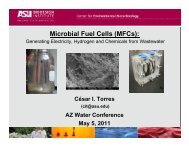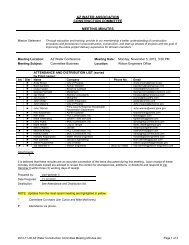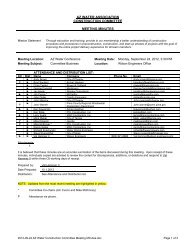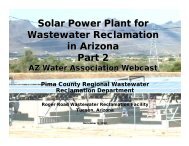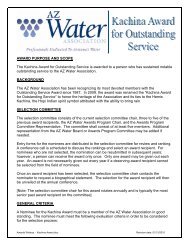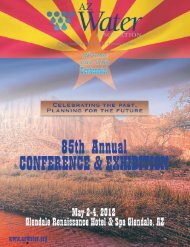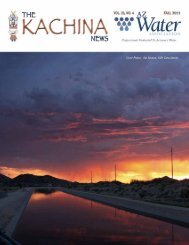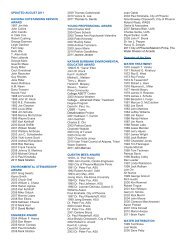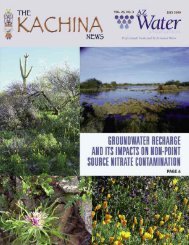Annual Conference Brochure - AZ Water Association
Annual Conference Brochure - AZ Water Association
Annual Conference Brochure - AZ Water Association
You also want an ePaper? Increase the reach of your titles
YUMPU automatically turns print PDFs into web optimized ePapers that Google loves.
TECHNICAL SESSIONS<br />
for aquifer recharge or indirect potable reuse. AOP differs<br />
in the method of generation of hydroxyl radicals, the<br />
primary agents of contaminant destruction. Learn how the<br />
production and fate of radicals generated via UV-dependent<br />
breakdown of hydrogen peroxide is analyzed mathematically<br />
to establish near-steady levels of radical concentrations and<br />
predict rates of disappearance of residual trace organics in<br />
treated waters. In its current form, the model can be used<br />
to optimize aspects of design and operation of UV/peroxide<br />
treatment systems.<br />
9:30 - 10:00am<br />
Bioremediation of Uranium in an Anaerobic<br />
Biofilm Reactor<br />
Jim Field, University of Arizona<br />
Groundwater contamination with hexavalent uranium<br />
(U(VI)) poses an environmental health risk due to<br />
chemotoxicity causing damage to kidneys after long-term<br />
exposures. Reductive precipitation of soluble U(VI) to<br />
insoluble tetravalent uranium (U(IV)) in the form of the<br />
mineral uraninite (UO2) is one of the more promising<br />
approaches to uranium remediation. The objective of this<br />
study was to evaluate whether methanogenic biofilms from<br />
high rate anaerobic wastewater treatment reactors have the<br />
capacity to catalyze the reductive precipitation of uranium<br />
and be applied as a treatment technology for removing<br />
uranium from groundwater. Two methods were used to<br />
confirm the presence of uraninite as the dominant species<br />
of uranium accumulating in the solid phase.<br />
10:30 - 11:00am<br />
An Analysis of DOC Removal at CAVSARP and the<br />
Potential for Groundwater Recharge in the Phoenix<br />
Metropolitan Area<br />
Sean Wilson, Arizona State University<br />
The organic carbon removal capacity of CAVSARP was<br />
evaluated using the historical data. CAVSARP is a<br />
groundwater recharge project that is actually providing<br />
water treatment, since the water is recovered for potable<br />
purposes. The evaluation of CAVSARP was extrapolated to<br />
determine how groundwater recharge could enhance water<br />
quality in the Phoenix Metropolitan Area.<br />
11:00 - 11:30am<br />
Scale Control in a Simulated Cooling Tower Using a<br />
Physical <strong>Water</strong> Treatment Device<br />
Tiffany Yee, Arizona State University<br />
Decreasing water use in cooling towers can be done by<br />
increasing the cycles of concentration which usually requires<br />
chemical treatment to prevent scale formation. A simulated<br />
cooling tower was operated with and without a physical<br />
water treatment device to determine if scaling could<br />
be prevented at increasing cycles of concentration. The<br />
potential for the physical water treatment device to remove<br />
existing scale was also evaluated.<br />
11:30 - 12:00pm<br />
An Evaluation of Alternatives to Domestic Ion<br />
Exchange <strong>Water</strong> Softeners<br />
Mara Ramos, Arizona State University<br />
Domestic Ion Exchange water softeners limit the ability to<br />
reuse water for many applications. Four different alternative<br />
technologies were evaluated for their ability to prevent scale<br />
formation in a water heater using three different water<br />
sources. All of the technologies were capable of reducing<br />
scale formation, and two of the technologies were very<br />
effective.<br />
1:30 - 2:00pm<br />
Development of A Catalytic Ozonation Fixed Bed<br />
Reactor for Advanced Treatment of Wastewater Using<br />
Titanium Dioxide<br />
Michelle Barry, Arizona State University<br />
This research focuses on reactor design of a catalytic<br />
24<br />
ozonation system as an advanced treatment process. More<br />
specifically, the goals are to: (1) develop a model of a<br />
fixed-bed reactor; (2) conduct bench scale tests to identify<br />
catalyst and ozone concentrations for optimal reaction<br />
rates; and (3) develop and test a bench-scale fixed bed<br />
reactor design.<br />
2:00 - 2:30pm<br />
Photocatalytic Nitrate Reduction<br />
Kyle Doudrick, Arizona State University<br />
Nitrate is a prevalent pollutant in groundwater and is often<br />
a reason limiting the use of these local resources. Research<br />
into reducing nitrate to nitrogen gas during photolysis in the<br />
presence of commercially available and tailored titanium<br />
dioxide catalysts are discussed with the initial eye towards<br />
treating ion exchange brine.<br />
2:30 - 3:00pm<br />
Removal of Engineered Nanomaterials During<br />
Wastewater Treatment<br />
Yifei Wang, Arizona State University<br />
Engineered nanomaterials from titanium dioxide, nanosilver<br />
and others are or will be entering our wastewater systems.<br />
Understanding the ability to remove these potential<br />
emerging pollutants is the focus of this talk. Specifically, the<br />
talk focuses on long-term operation of a sequencing batch<br />
activated sludge reactor exposed to nanomaterials.<br />
3:00 - 3:30pm<br />
Removal of Emerging Pollutants in Constructed<br />
Wetlands<br />
Fariya Sharif, Arizona State University<br />
This presentation will include a background primarily stating<br />
the purpose of the study. An overview of the existing<br />
wetlands will be presented which will include the design<br />
features and removal trends for bulk and trace pollutants.<br />
Selected target compounds will be presented with the<br />
justification for their selection, physico-chemical properties<br />
and the analytical strategies used for quantification.<br />
Details of the laboratory experiments will be included<br />
in the presentation. Wetland mesocosms, abiotic and<br />
biotic experiments will be briefly discussed. Data from the<br />
experiments will be presented to determine the relationships<br />
between design hydraulic loading rates and emerging<br />
compound removal. Based on the experimental data, abiotic<br />
and biotic processes will also be evaluated for the selected<br />
compounds. Scope for the future work will be addressed.<br />
TRACK 4 - APPLICATIONS IN<br />
HYDRAULIC MODELING<br />
8:00 - 8:30am<br />
Hydraulic Modeling: An Important Process in a <strong>Water</strong><br />
Infrastructure Master Plan<br />
Nabin Khanal, ARCADIS / Malcolm Pirnie, Inc.<br />
This presentation will stress on the importance of hydraulic<br />
modeling in a water infrastructure master planning process.<br />
8:30 - 9:00am<br />
Using <strong>Water</strong> Distribution System Modeling, DBP<br />
Modeling, and SDS Testing of CAP <strong>Water</strong> to Develop<br />
an Optimum <strong>Water</strong> Quality Solution for the Ak-Chin<br />
Indian Community<br />
Lisa Snyders, Carollo Engineers<br />
The Ak-Chin Indian Community has historically utilized<br />
groundwater as the primary source of potable water.<br />
However, continued deterioration of groundwater quality,<br />
recent struggles associated with identifying and obtaining<br />
a new high quality groundwater source, and availability of<br />
a Central Arizona Project (CAP) surface water supply have<br />
prompted the Community to design and construct a new<br />
surface water treatment plant (SWTP). This presentation will<br />
describe how distribution system modeling, DBP formation<br />
modeling, and water quality sampling and testing of the<br />
CAP surface water were successfully combined to develop<br />
optimum DBP mitigation strategies including enhanced<br />
coagulation, Granular Activated Carbon (GAC) contactors,<br />
and various distribution system operational strategies.<br />
9:00 - 9:30am<br />
Agua Fria Optimization Study for Arizona American<br />
<strong>Water</strong> Company<br />
Pranam Joshi, NCS Engineers, Alex Louisetto, Arizona<br />
American <strong>Water</strong> Company<br />
A hydraulic model was created for Arizona American <strong>Water</strong><br />
Company to develop a strategy for incorporating a new<br />
surface water treatment plant into the Agua Fria <strong>Water</strong><br />
District (AFWD) service area. AFWD has groundwater sources<br />
as well as the new surface water treatment plant. The<br />
purpose of the model was to identify cost optimal solutions<br />
that satisfy demands, maintain water quality, and balance<br />
the system’s numerous constraints. The model used data<br />
from the SCADA system and data collected in the field.<br />
Calibration was done using real data from locations in the<br />
distribution system. A genetic algorithm was created to find<br />
the optimal solution.<br />
9:30 - 10:00am<br />
<strong>Water</strong> Distribution System Supply Reversal: The Town<br />
of Payson Conversion from a Multiple Groundwater<br />
Well Supply to a Single Source by the Flip of a Switch<br />
Tanner D. Henry, Tetra Tech, Inc.<br />
The Town of Payson <strong>Water</strong> Distribution system currently<br />
serves approximately 17,000 people with drinking water<br />
from 42 active groundwater wells. As a part of the Arizona<br />
<strong>Water</strong> Settlement Act, the Salt River Project acquired the<br />
C.C. Cragin Reservoir and infrastructure from Phelps Dodge<br />
Corporation. Accordingly, the C.C. Cragin reservoir became<br />
a viable alternative for supply of 3,000 acre-feet of water<br />
being delivered for nine months per year. Tetra Tech, Inc.<br />
developed a plan to reverse flow to the existing 25 pressure<br />
zones, 10 booster stations, and 12 storage tanks with<br />
minimal infrastructure. The proposed infrastructure will<br />
convert the system annually to the new single source by<br />
activating a single booster station. The presentation will<br />
cover the evaluation of the existing system, planning, and<br />
modeling of the proposed design.<br />
10:30 - 11:00am<br />
Two Approaches for Identifying Optimal <strong>Water</strong><br />
Security Monitoring Station Locations in the<br />
Distribution System Using TEVA-SPOT<br />
Brad Jeppson, Carollo Engineers<br />
Learn about the advantages and disadvantages of two<br />
methods for optimizing on-line distribution system security<br />
monitoring using TEVA-SPOT software tool.<br />
11:00 - 11:30am<br />
City of Scottsdale Wastewater Model Update<br />
Bill Roberts, GHD, Inc.<br />
This presentation focuses on the lessons learned by GHD<br />
Inc and the City of Scottsdale during the recent update<br />
of the City’s wastewater model. The model now reflects<br />
the economic changes that have occurred over the last<br />
five years and illustrates the importance of accounting for<br />
Rain Derived Infiltration and Inflow (RDII). The recent<br />
loading revisions were based on billing data allocated within<br />
the model using GIS information. Those flows were then<br />
calibrated with data collected at more than 35 meter sites<br />
throughout the City’s collection system. GHD also created<br />
current day and future built out models with steady state<br />
and extended period scenarios that addressed wet weather<br />
flows and RDII using model generated storms that were<br />
calibrated against recorded data.<br />
<strong>AZ</strong> <strong>Water</strong> <strong>Association</strong> 84th <strong>Annual</strong> <strong>Conference</strong> & Exhibition Arizona’s <strong>Water</strong> Future is Here!





